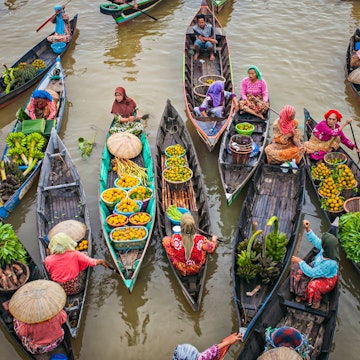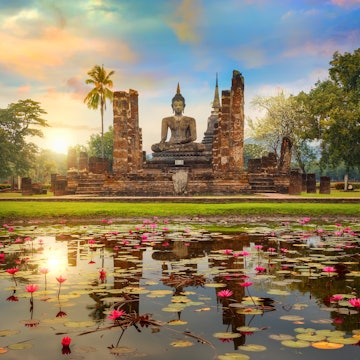
The Lonely Planet guide to Indonesia's Prambanan Temple Complex

Apr 30, 2025 • 8 min read

The Prambanan Temple Complex is Indonesia's most important Hindu site. Mazur Travel/Shutterstock
The most significant Hindu site on the Indonesian island of Java rises dramatically from a flat plain to the northeast of Yogyakarta, the nation’s ancient capital of art and culture. The Prambanan Temple Complex covers not one temple, but hundreds of temples, ranging from tiny toppled shrines to the carving-covered towers of the mighty Shiva, Vishnu and Brahma temples that form the heart of this ancient site.
Constructed in the 9th century CE, these three ancient temples – devoted to the Trimurti, the trio of Hindu deities responsible for creating, preserving and destroying the universe – are the centerpiece for a vast religious complex sprawling across 40 hectares (99 acres) of green parkland.
Although many of Prambanan’s ancient stone structures lie in ruins, this is the second largest Hindu temple complex in Southeast Asia after Cambodia’s Angkor Wat – and an undisputed highlight of the island of Java. It’s often visited on a day trip from Yogyakarta along with nearby Borobudur.
Today, the site offers a chance to time travel into Indonesia’s layered past, where Hindu, Buddhist and Islamic kingdoms jostled for power, both against each other and against the forces of nature. Earthquakes toppled many of the temples in ancient times, before the key structures were restored by archaeologists in the early 20th century.
From the essential temples to explore to the best times to visit, here’s everything you need to know about Indonesia’s Prambanan Temple Complex.

What’s the history of the Prambanan Temple Complex?
Construction of the Prambanan Temples was most likely initiated in the 9th century by Rakai Pikatan, leader of the Hindu Mataram kingdom, and completed by his successor Lokapala. Many historians believe the temple was built as a statement of Hindu power – a response in stone to the construction of the Buddhist complex at Borobudur by the rival Sailendra dynasty some 50 years earlier.
The creation of Prambanan marked a key shift in belief in the Mataram kingdom, which turned from Mahayana Buddhism to Shaivite Hinduism before Islam rose to prominence across Java. Both Borobudur and Prambanan were abandoned in the 10th century – perhaps due to eruptions of Mt Merapi – and Mataram became a powerful Muslim sultanate, before falling to the Dutch in the 1740s.
It was the Dutch who took the first steps to restore the temples, which were toppled by severe earthquakes in the 16th century. The site was cleared of vegetation in 1805, and half-hearted excavation attempts followed in the 1880s, before the temple towers were painstakingly reassembled between 1913 and 1953.
When should I go to the Prambanan Temple Complex?
The Prambanan Temple Complex is open from 6:30am to 5pm daily except Monday. Try to reach the site at opening time, so you can enjoy a more contemplative experience of this ancient sacred site before the tour groups arrive. The easiest option is to come with your own transport so you can reach the complex as the gates open, but you can also get here from Yogyakarta on bus 1A. It's easy to arrange a rental scooter, taxi or chartered car and driver in Yogyakarta.
The late afternoon, just before closing time, is also a good time to visit, as the pre-sunset light bathes Prambanan in a warm glow (enter before the ticket desk closes at 5pm). Try to avoid the middle of the day, when temperatures can feel uncomfortably hot. With Indonesia’s monsoon-influenced climate, the best season to visit is from May to October – the driest time of year.
How much time should I spend at the Prambanan Temple Complex?
Allow at least half a day to explore, and longer if you plan to check out the outlying ruins beyond the main Shiva, Vishnu and Brahma temples. There’s plenty to see if you’re a committed temple fan – consider bringing a picnic lunch, then stop in for a more substantial meal at one of the nearby restaurants when you’ve finished exploring the temples.

What’s the best way to see the Prambanan Temples?
The Prambanan Temple site is well signposted and not overly complicated to navigate, but the ruins are spread out and it takes time to reach the outlying temples. To get the most out of the experience, hire a local guide inside the main entrance.
As well as knowing all the history, a guide will add real value to your visit, taking you to places that you cannot go without one. They also know the best spots and angles for photos, plus shortcuts between the temples and ruins – information that’s worth its weight in gold on a hot, humid day.
How much do tickets cost?
Tour agencies can make bookings as part of day tours from Yogyakarta, but it’s easy to buy tickets on arrival at the complex. The standard ticket costs the equivalent of US$25 for foreign adult visitors, with discounts for children under 10 years.
You can also buy combination tickets covering Prambanan and Borobudur, or Prambanan and Kraton Ratu Boko – a ruined palace complex about 3km (1.9 miles) from the site (a shuttle bus is included in the price).
What should I eat and drink at Prambanan?
If you plan to visit over lunchtime, one option is to bring a picnic lunch of fresh fruit and portable Indonesian snacks such as nasi lemak (coconut rice and sundries, packed inside banana leaves) or lemper (steamed, stuffed sticky rice parcels).
Alternatively, you can enjoy a more substantial meal at one of the many restaurants near the ruins once you’ve finished exploring the temples. For homestyle Indonesian cooking, head north of the ruins to Wedang Kopi Prambanan or Kali Opak Resto. For a posher meal with a view, try Rama Shinta Garden Resto immediately west of the temples.

What are Prambanan’s must-sees?
The Prambanan temples sprawl over a large area – if you only have time for a short visit, concentrate on the three main temples and the surrounding ruined shrines.
Shiva, Vishnu & Brahma Temples
The three main temples at Prambanan – all impressively restored – tower 47m (154ft) above the surrounding plain, making them taller than even Borobudur. Modelled after the temples of India but with unmistakable Javan influences, these striking stone temples mark an architectural mid-point between the shikhara temple spires common in India and the Buddhist prang towers popular in mainland Southeast Asia.
The temples are dedicated to the Hindu gods Brahma (the creator of the universe), Vishnu (the preserver of the universe) and Shiva (the cosmic destroyer), who gets the largest temple. All three temples are lavishly carved with ornamental details and deities, and flanking shrines are dedicated to their vahanas (beings that serve as mystical vehicles for the gods). Look out for the bas reliefs showing scenes from the Ramayana and Bhagavata Purana – two of the Hindu epics.
Inside the Shiva Temple, a four-armed statue of Shiva as Mahadeva, the supreme being, stands on a lotus pedestal – a symbol of Buddhism – while flanking chambers contain statues of elephant-headed Ganesh, Durga slaying the buffalo demon Mahishasura, and potbellied and bearded Agastya, the divine teacher.
Surrounding these three structures is a vast complex of 224 pervara (ancillary) temples, arranged in concentric rings. Most are unrestored ruins, lying much as they fell after the 16th-century earthquake that toppled the site.

Outlying temples
Away from the main complex lie three smaller temple complexes that many visitors are unaware of unless they visit with a guide. To reach them, head north from the main temple group. On a hot day, consider hiring a shuttle to take you around, as it’s 1km (0.6 miles) to the furthest temple.
You’ll first reach the small Lumbung Temple – a time-scarred Buddhist shrine surrounded by its own small cluster of pervara temples. Next is the Bubrah Temple, whose name means “in ruins” – though in fact, this Buddhist temple was impressively restored in 2017.
The most northerly temple, Sewu, is the largest and most impressive structure beyond the main group, and it’s well worth investigating. This Buddhist temple was constructed in the 8th century – earlier than the main group temples – and it may originally have been sacred to the bodhisattva (enlightened being) Manjushri. It's the second largest Buddhist temple in Java, after Borobudur.
Museum Candi Prambanan
To learn more about Prambanan’s rich history, visit the Museum Candi Prambanan, just south of the Lumbung Temple, which is home to a collection of Buddhist and Hindu artifacts, statues and fossils discovered in the area.

Prambanan Ramayana Ballet
If you visit in the afternoon, you can stick around until the evening to see Javanese dancers retelling stories from the Hindu epic, the Ramayana, at the Prambanan Ramayana Ballet, just west of the main temple group. Shows take place indoors in the wet season and outdoors in the dry season, with the Prambanan temples as a backdrop. The show usually starts at 7:30pm on Tuesday, Thursday and Saturday evenings.
Kraton Ratu Boka
It’s well worth taking a detour to the ruins of Kraton Ratu Boko, set on a hilltop about 3km (1.9 miles) from Prambanan; if you purchased a combined ticket, a shuttle bus transfer is included in the price. Unlike the temple ruins in the area, this site appears to have been a fortified royal settlement, complete with a kraton (palace), bathing pools and a dried-up moat.
It is unclear what most of the structures here were used for, apart from the pools, which were used for the princesses and concubines of the king for bathing. Taking a walk around the ruins in the late afternoon as the sky fills with sunset colors is a highly rewarding experience. If you want some memorable photos, the setting sun is framed by the ruins of a large gateway at the entrance to the complex.
Is Prambanan accessible?
Visitors with limited mobility should be able to admire the exteriors of the temples without too much difficulty, but seeing the interiors of the shrines is trickier because of steps and uneven surfaces. Ramps allow access to some sections of the shrines, and specialist tour operators such as Accessible Indonesia are permitted to use modified vehicles on site, and can help visitors reach some more inaccessible areas.
This article was adapted from Lonely Planet’s Indonesia guidebook, published in July 2024.















